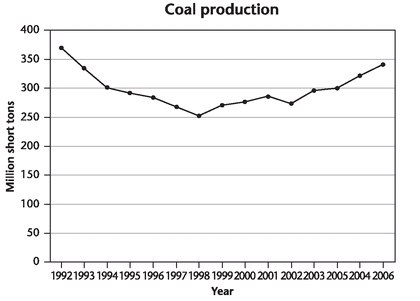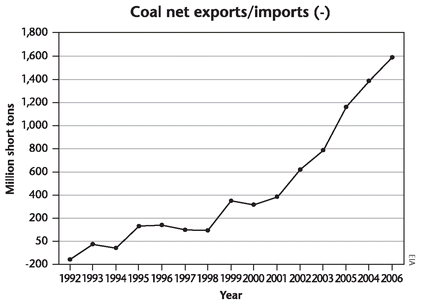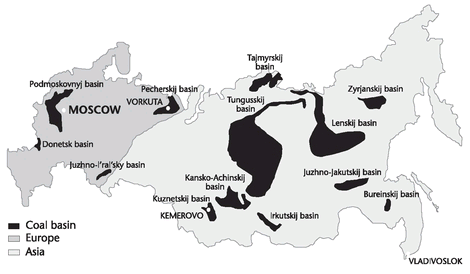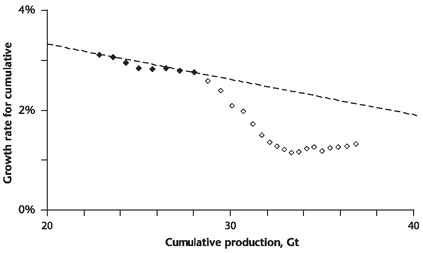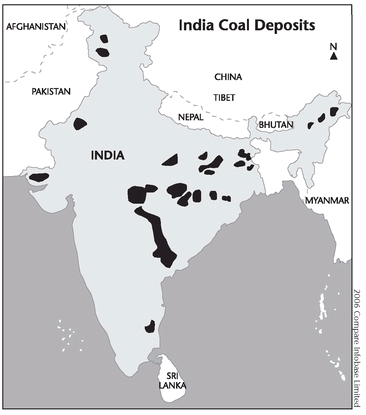CHAPTER 4
Coal in Russia and India
Russia
Overview
ACCORDING TO THE WORLD ENERGY COUNCIL, the Russian Federation has the highest coal reserves-to-production ratio for any nation in the world, at 500:1. This should not be taken to mean that the country has 500 years worth of coal, for reasons discussed at length in Chapter 1; nevertheless, the figure is not without significance. Russia’s official coal reserves are the world’s second-largest, and many of its potential coalfields have yet to be developed.
Coal dominated Russia’s energy history from the late 19th century until the 1960s, when the country’s vast reserves of gas and oil began to be vigorously exploited and major coal-producing areas in the Donetsk Basin neared exhaustion. Coal-powered industry was the backbone of early Soviet industrial expansion, and many industrial centers were sited near coal mines.
Coal production reached 121 thousand tons annually in 1860, grew quickly to 12 million tons (Mt) in 1900, and then to 34.5 Mt in 1916.
1 During and shortly after the 1917 revolution, production sharply declined and most mines were destroyed. In the 1920s, dozens of mines were restored and new ones developed, including some opencast mines. In the decade from 1928 to 1938, more than 200 mines were constructed, adding another 100 Mt of capacity.
Germany’s occupation of the eastern regions of the USSR during World War II resulted in the loss of 60 percent of previous coal production. This was compensated for by the intensive development of new production in areas further west that permitted surface mining (by 1945, opencast mines were producing 17.8 Mt, or almost 12 percent of total coal production).
The Soviet Union’s introduction of a new holiday — “Miners Day” — in 1947 demonstrated the prestige with which the profession was then regarded.
Mining science advanced during the 1960s and ’70s and large-scale manufacturing of modern mining equipment began. In 1988, coal production in Russia reached a peak of 425.4 Mt, but then gradually declined due to the age of the majority of mines, as well as their increasing average depth. Mine safety was becoming a more serious issue, contributing to mass strikes by miners in 1989-1990. Coal miners, who had been among the best-paid industrial workers of the Soviet era, were now experiencing long delays in receiving wages, as the nation’s economy nosedived.
In the early post-Soviet era, drastic measures were required to avert a collapse of the coal industry. These included the closing of the most dangerous mines and the privatization of others. Production in 1998 was 231 Mt — down by almost half from the peak in 1988. Still, during this time 11 new underground and 15 opencast mines were constructed in Kuzbass and other regions with a total capacity of 57 million tons per year. As a result of mechanization, the cost of coal production declined and productivity increased; employment in the coal sector fell from 900,000 in 1991 to 400,000 in 2001.
2 In the near future, the trend for improvement in productivity is likely to continue as Russia’s coal industry adopts more state-of-the-art machinery and practices.
While Russia’s coal industry was entirely state-owned during the Soviet era, private companies now account for more than 60 percent of domestic production and about 80 percent of exports.
Currently, hard coal production still takes place in the Russian part of the Donetsk Basin, near Ukraine, as well as the Kuznetsk and Pechora basins south of the Urals. The coal reserves in eastern Siberia and the Russian Far East, which consist mostly of subbituminous coal and lignite, are largely unexploited because of lack of transport infrastructure and distance from markets.
Russia’s total coal production in 2007 was 347 million tons, growing at a rate of just over two percent per year, while domestic consumption was about 261 million tons.
3Fig. 24a
Fig. 24b
Fig. 25
Coal provides around 17 percent of Russia’s primary energy and 30 percent of its electricity production. These percentages are expected to increase as Russia raises the share of its coal used internally so as to be able to export a greater proportion of its natural gas, which is easier to transport and more lucrative to sell internationally.
About 20 percent of Russia’s coal production is exported, more than half of that to Europe, and exports have been increasing dramatically in recent years. Indeed, most of the recent industry growth has been due to heightened exports. However, the Russian coal export industry suffers from high costs for transportation and port fees, and this may inhibit future export growth.
4Meanwhile, Russia’s domestic demand for coal is increasing as many new coal-fired power stations are being built (an additional 40 to 50 GW of capacity is expected to be installed between now and 2020, by which time domestic coal demand is expected to double).
5 In 2008, Russia faced the possibility of a hydropower shortage, which created more short-term domestic demand for coal. But even without the hydropower shortage, Russian coal exports were expected to decline by 10 to 12 million tons the following year.
6 This new trend for declining coal exports will likely continue, and Russia could well cease being an exporter within only a few years.
History of Reserves Estimates
During the Soviet era, recoverable coal reserves were estimated to be in the range of 300 to 400 billion tons — equivalent to about 30 percent of current total world reserves. However, the Soviet regime evaluated mineral resources using economic criteria different from those employed in the West. After the collapse and break-up of the USSR, new reserves definitions and estimation practices were introduced, taking into account minimum seam thickness, ash content, unfavorable geological conditions, and the remoteness of many coalfields. The resulting re-estimation of reserves is still ongoing, and will undoubtedly remove a substantial portion of current reserves from the national inventory when completed. The 2007 edition of the BP “Statistical Review” and the WEC both list Russia’s total coal reserves as 157,010 million tons. When better reporting practices are fully adopted this figure could decline by up to a third.
7
Recent Studies
1
“Coal: Resources and Future Production” (Werner Zittel and Jörg Schindler, Energy Watch Group [EWG], March 2007).
The EWG Report does not include a separate annex on Russia. The authors’ expectation, as represented in their graph for future world coal production (see
Figure 4 in Chapter 1), is for an increase in production from this country lasting until about 2050, with only a very slow decline afterward. However, they note that “it is by no means certain that [the] reported reserves [of former Soviet Union countries, principally Russia] will ever translate into corresponding production volumes.”
8 They justify this by noting that:
Some doubts regarding the data quality of the coal reserve data for the former Soviet Union countries remain as the last update was carried out in 1998. Therefore, it is probably more realistic to expect the decline after peak to be steeper than shown in the [world future coal supply] figure.
2
“The Future of Coal” (B. Kavalov and S.D. Peteves, Institute for Energy, 2007).
This report offers a pessimistic assessment for prospects of Russian coal. After discussing the problems with the eastern coal reserves’ location and lack of rail and seaport facilities, the authors note that, “Consequently, Russia is a relatively expensive producer of coal, competitive on the world market only when international coal prices are high.”
9 They point out also that Kazakhstan is in a similar situation.
To make matters worse, “Coal production and exports suffer from a generally low level of mechanization and productivity, as well as poor mine safety.”
The report’s conclusion is that, “Taking into account all the above factors, Russia no longer appears to be a coal-rich country.”
3
“Lignite and Hard Coal: Energy Suppliers for World Needs until the Year 2100 — An Outlook” (Thomas Thielemann, Sandro Schmidt, and J. Peter Gerling, German Federal Institute for Geosciences and Natural Resources [BGR], 2007).
This report offers few specifics regarding future trends for Russian coal. However, due to higher consumption rates in the United States, the authors conclude that, in the period from 2050 to 2100, Russia will retain the “biggest hard coal reserves, with an abundant 129 Gt (40% [of world total]) in 2100, followed by North America (94.9 Gt, 29.6%), Oceania (34 Gt, 10.6%), [and] Asia (31.6 Gt, 9.8%).”
10 The passage would seem to indicate that the authors expect Russia’s reserves to grow dramatically during the century, although the recent trend has been toward downward revision.
4
“A Supply-Driven Forecast for the Future Global Coal Production” (Höök, Zittel, Schindler, and Aleklett; Uppsala Hydrocarbon Depletion Study Group).
This paper, unlike the earlier EWG report, does offer a section specifically devoted to Russia’s future coal supplies. Its conclusions are somewhat self-contradictory, however. While the section begins with the broad and reassuring statement that, “Russian coal reserves are vast, and will be more than enough for the future with expected production and demand trends,” it goes on to say that, “In reality this would mean a large-scale development of the Siberian reserves.”
11 However, the authors note the difficulty of this actually occurring:
Russia has plenty of new coal regions that can be developed, but most of these are located in Siberia or the eastern parts of Russia. Much of the coal is thus essentially stranded inside Siberia, far from potential markets and major consumption regions. An improvement of the transportation systems is needed to make these coal regions really useable. The Russian coal assets in Siberia are comparable with the situation in Montana. Due to the remoteness from the market and the huge need for infrastructure investments in new coalmines, transport systems, and trade ports it is very questionable if they ever will be developed.
Höök et al. note that “[Russian] coalfields near Europe are declining and will have to be abandoned sometime in the future,” and that, “The majority of the Russian coal deposits [i.e., those in Siberia] are subbituminous and lignite, thus making them less suitable for longer transport and export.” The section ends with an upbeat but somewhat perplexing statement: “The production forecast does not consider any of the problems mentioned here as constraints and depicts a continued production growth as new areas and mines are brought into production as long as the reserves allow.”
5
Hubbert linearization.
David Rutledge finds that the Hubbert linearization trend for Russia’s coal production indicates remaining reserves of only 30 billion tons.
12 This apparently very low figure results from the fact that Siberian resources are for the most part yet to be tapped, and therefore do not contribute to the trend. Thus, the figure should be regarded as the lower boundary on future production, in the case that transport issues or other problems prevent the far-eastern deposits from being developed.
Implications
Russia is one of the few nations that may be able to count on coal as a primary source of energy for several decades to come — even with slowly growing rates of consumption; but this outcome hinges almost entirely on the development of Siberian reserves. There are mines already operating in the region, where mine safety is an issue. However, expansion of mining activity in Tunguska and regions further east will require overcoming not only safety problems, but daunting logistical hurdles as well, especially with regard to transportation.
Fig. 26
There are currently approximately 20,000 rail wagons in Russia, but old wagons are falling apart three times as fast as they are being replaced. About 10,000 new wagons — which cost $40,000 apiece — are needed, but they are in short supply even when there is investment capital available to purchase them.
13Because much of the eastern coal is of low quality, long-distance transport either to population centers in the east or to seaports in the west may be hard to justify on economic grounds. A solution could be to build power plants close to mines and transmit electricity to western markets — but this would also entail huge infrastructure investments.
Further, expansion of mining in Siberia will entail horrific environmental costs. Surface mining would result in deforestation or would disrupt environmentally sensitive tundra; meanwhile, indigenous peoples throughout the sparsely populated region — which is already hard-hit by the effects of climate change — would be displaced or would suffer further degradation of their fragile ecosystems.
All of these considerations play into the question of Russia’s actual coal reserves. If it is assumed that Siberian coal will be developed on a grand scale, then the nation’s reserves are correspondingly large. If Siberia is assumed to continue being a minor coal producer, then Russia’s coal reserves may already be largely tapped out: accepting the Hubbert linearization trend identified by Rutledge (which includes very little contribution from Siberia and sees 30 billion tons remaining) as a likely limit on future production, this would suggest that Russia’s peak in coal production will occur very soon or may already have passed.
Russia certainly has incentives to develop its eastern coal resources: while the nation’s oil and gas are still plentiful, these can be exported to earn foreign exchange income; coal is more sensibly used domestically. Russia’s oil production has been falling recently, and many analysts believe that the decline will continue.
14 Nevertheless, the country is still vying with Saudi Arabia as the world’s largest oil producer. Russia’s Gazprom, which sells natural gas to Europe, has recently become the world’s largest energy company. Higher-grade fossil fuels are supplying Russia with both cash and geopolitical clout. Therefore the nation’s leaders would no doubt prefer to maximize these benefits by running the domestic economy more intensively on coal.
Thus, efforts surely will be made to develop Siberia’s coal, though it is unclear how far those efforts will proceed before practical limits constrain them. Meanwhile, the looming consequences for the expansive eastern region will likely provoke a political backlash from indigenous rights groups.
Because Siberia’s coal is of relatively low quality, it will produce high carbon emissions relative to energy; thus the development of this resource would also prevent Russia from honoring existing or future climate accords.
One path would avert many of these problems: Russia could build highly efficient gasification power plants in Siberia, sequester carbon, transmit electricity to markets in the west and to China, and contribute financially to the economic welfare of the indigenous peoples of the region. This would be an extremely expensive strategy to pursue. Moreover, at some point, it would become a problem not merely of financial return on financial investment, but of energy return on energy investment: if energy profit ratios drop much below about ten to one, the effort to provide energy to society itself begins to take up a disproportionate share of society’s energy budget. Only a complex and extensive study will determine how much of Siberia’s coal can potentially be extracted and used while delivering substantial net energy, but the Russian government would be well advised to undertake such a study before committing itself to the large-scale development of its eastern coal deposits.
India
Overview
India’s situation is somewhat similar to that of China, in that it is a populous country experiencing fast economic growth based largely on coal. Consumption of the resource increased from 360 million tons in 2000 to 460 million tons in 2005 — a growth rate of 5.5 percent per year. Coal now provides 53 percent of India’s total energy. It is the nation’s most abundant fossil fuel, and 68 percent of India’s CO
2 emissions are from the burning of coal. The country’s coal R/P ratio exceeds 200, well above the world average.
15Coal production commenced early in this nation’s colonial history, when Warren Hastings began commercial mining in West Bengal in 1774. However, lack of transport facilities resulted in minimal development until 1900, when rail infrastructure began to knit the region together. Production capacity reached six million tons per year by the early 1900s. Following independence in 1947, output accelerated; and the pace grew once again following the formation of the nationalized company, Coal India, in the early 1970s. By the end of the 1990s, India ranked third in world hard coal production, behind China and the United States.
Nearly all of the nation’s coal is produced by the state-owned monopoly, Coal India Ltd. (CIL), which is the world’s largest coal company, with 473 mines and 424,000 employees.
16 Coal India expects its production to achieve 520 million tons by 2011-12 and 665 million tons by 2016-17.
17India’s coal is distributed over a number of relatively small basins, mostly in the eastern and southeastern regions. Nearly all the deposits are of hard coal, with some lignite in the northwestern region which is mined for electricity generation; however, most of the resource is of low grade and of low quality, with unusually high ash content. This makes Indian coal unsuitable for export, and it also creates unusually high amounts of fly ash at the country’s power stations.
18More than three-quarters of India’s coal is produced by surface mining; underground mining accounts for the remaining output, and most of the latter is accomplished by room-and-pillar methods.
Aside from resource quality, the main problem for India’s coal industry continues to be lack of sufficient transportation infrastructure. A little over half of mined coal is hauled by rail, almost 20 percent by truck, and the rest by sea and other means (including conveyor belts and rope-ways). Truck transport is becoming increasingly expensive as a result of high diesel fuel prices, and rail infrastructure is inadequate to move growing quantities of coal.
India’s coal consumption is now slightly under 500 million tons per year, while production is running at just over 400 million tons.
19 The shortfall of about 100 million tons needs to be made up by a growing share of imports. However, the number of Indian ports that can handle coal is limited, and a lack of rail wagons and a shortage of locomotives makes it difficult to reliably transport coal from port to power plant even when imports are available.
Fig. 27
Recently the nation’s power plants faced coal shortages, as CIL lowered its supply projection for 2008-09 from 305 million tons to 292.15 million tons.
20 This is a clear indication that the infrastructure constraints described above are already having a serious impact on India’s coal industry.
History of Reserves Estimates
Indian hard coal reserves were upgraded from 12.6 billion tons in 1987 to 90 billion tons in 2005. This is the only instance globally of such a large and recent expansion of reserves (Australia has also posted reserves increases, but on a smaller scale). However, in the WEC 2007 survey, India reduced its reserves from 92Gt to 56Gt, which reflects a transition in reporting from “coal in place” to “recoverable coal.”
Recent Studies
1
“Coal: Resources and Future Production” (Werner Zittel and Jörg Schindler, Energy Watch Group [EWG], March 2007).
This report has very few details on India’s coal. The large, recent upward reserves revisions are noted, and the authors point out that, “All other countries have individually downgraded their hard coal reserves by a combined 35 percent over the same period.”
21 Their general conclusion is that “the data quality is very poor and the reported data cannot be regarded as a realistic assessment of ‘proved recoverable coal reserves’”;
22 however, they do not provide any evidence or argument regarding data quality specific to India.
2
“The Future of Coal” (B. Kavalov and S.D. Peteves, Institute for Energy, 2007).
This report points out the problems of resource quality noted above and goes on to say that, “Although the gross R/P ratio is high, the amount of realistically exploitable reserves is uncertain.”
23 The authors offer a fairly detailed assessment of India’s daunting challenges with developing its coal industry further:
• At present, most Indian coal is mined at depths of 150- 300 metres. The deposits at such depths may be sufficient for 50-60 years only. The recovery of deeper reserves may be precluded by excessively high costs.
• Most coal mines are state-owned, a fact that constrains private investment in the sector. Investment in coal supply is particularly impeded by distribution regulations and control over foreign investment.
• The operation of coal mines is outdated and productivity is very low compared to international standards, especially in underground mining.
• Most coal deposits are located in the northeast part of the country, while the major consumption centers are in the west and southwest (including coastal) areas of the country. Bringing coal to the major consumers, especially in unwashed form, involves expensive transport by rail over large distances (500-750 km). Transport costs may account for up to 70% of total delivery costs.
• For a number of reasons, including the presence of three different gauges, the condition of the Indian railways is far from perfect. Improving the railways calls for huge investment, which does not seem realistic in the foreseeable future.
• For these reasons, and also to improve average coal quality, many power plant operators in the west and southwest parts of India are importing increasing volumes of higher-quality steam coal.
• The power generation sector is heavily regulated and electricity prices are kept at very low levels that basically preclude investment. Power plant operators have little incentive to invest in improving coal quality, the development of logistical infrastructure or the modernisation of power plants.
• Most power plants are over-aged, outdated, and consequently inefficient.
3
“Lignite and Hard Coal: Energy Suppliers for World Needs until the Year 2100 — An Outlook” (Thomas Thielemann, Sandro Schmidt, and J. Peter Gerling, German Federal Institute for Geosciences and Natural Resources [BGR], 2007).
This report provides no detail on India. The most relevant passage may be: “Asia’s ... thirst for energy will pose huge challenges for Asia’s energy supply throughout the entire century, from a deposit standpoint it will be possible to cover the rising demand using Asian coal deposits and the world market.”
24
4
“A Supply-Driven Forecast for the Future Global Coal Production” (Höök, Zittel, Schindler, and Aleklett; Uppsala Hydrocarbon Depletion Study Group).
The authors note that, “Tata Power, India’s largest power company in the public sector, signed a contract with an Indonesian coal company, which entitles Tata Power the right to buy 10 Mt of coal annually.”
25 This raises the question: “If the Indian coal supply was reliable and vast, why sign such an import contract?” They go on:
Also Tata Steel, another giant company of Tata Group, entered a memorandum of understanding with Riversdale Mining and acquired a 35% stake of its Mozambique coal projects and earlier signed an agreement with an Australian company for a 5% share of a coal project in Queensland. These can also be seen as signs that the Indian coal reserve is actually smaller than reported or that a large part of them is unusable for commercial enterprises or possibly that imported coal is cheaper.
Nevertheless, Höök, et al., use the stated reserves figure in their forecast for future global coal supply: “The production forecast does not take any of the mentioned economic problems into account and only portrays a logistically increasing production in line with the reserves.”
5
Hubbert linearization.
David Rutledge writes that, “For South Asia, and Central and South America, there has been exponential growth in recent years, so there is no trend.”
26 Therefore, for the purposes of assessing global recoverable reserves, he simply adopts the published reserves figures — which, he notes, “are likely to be too high.”
Implications
India will likely remain a highly coal-dependent nation for many years to come, since it has few other options for generating increasing amounts of electricity. Electricity demand is set to expand along with the nation’s fast-growing economy. Currently the electrification rate is still low, especially in rural areas, where the average grid connection level is only 30 percent.
But, as with China, limits to domestic coal supplies may loom sooner rather than later. As Kavalov and Peteves point out, transportation is a limiting factor; but also, for India, there are serious problems with resource quality, which may call current reserves figures into question. Further, because so much of India’s coal is surface mined, a substantial expansion of production in this very populous nation will likely entail not only deforestation and other environmental consequences, but also the removal of many villages. Such a massive relocation of people would pose daunting social and political challenges for the affected regions, and possibly for the central government as well.
The solution — already being implemented — is simply to import more coal. But imports are likely to be impeded by poor port infrastructure and resulting port congestion and vessel delays (on top of the usual heavy delays during the monsoon season). And the lack of adequate rail infrastructure connecting ports with power plants must also be addressed.
Further, since other nations in the region are also looking to buy more coal on the international market, prices for imported coal are likely to rise considerably in the years ahead. Given the size of India’s economy, even a modest increase in imports will challenge the capacity limits of international suppliers.
Altogether, then, India’s coal dependency poses extremely serious economic, social, and environmental problems for the nation’s future. As international coal prices rise, the nation is likely to endure economic contraction, unless alternative sources of energy can be developed extremely rapidly.
As of July 2008, India’s energy shortages appeared even more serious than those in China. Its nuclear power plants are failing for lack of water, as is hydropower — both because glaciers in the Himalayas are melting due to global warming. Over 85 percent of India’s oil is imported and domestic prices are subsidized. The resulting increased fuel costs are taking a heavy toll on the state budget. While the situation in India is not yet as bad as that in neighboring Pakistan, blackouts and liquid fuel shortages are being reported almost daily somewhere in the country. There is no end in sight to this situation other than through falling energy demand resulting from the global financial crisis.
